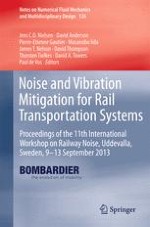
2015 | OriginalPaper | Chapter
Railway Noise Control in Europe: Current Status
Author : J. Oertli
Published in: Noise and Vibration Mitigation for Rail Transportation Systems
Publisher: Springer Berlin Heidelberg
Activate our intelligent search to find suitable subject content or patents.
Select sections of text to find matching patents with Artificial Intelligence. powered by
Select sections of text to find additional relevant content using AI-assisted search. powered by
Railways are a sustainable means of transport. Nonetheless, railways do have an influence on the environment. The most important effect is noise, especially the noise emitted from freight trains.
European Union policy supports noise reduction and has addressed the issue in interoperability directives and corresponding technical specifications. The Environmental Noise Directive (END) requires member states to submit noise maps and action plans. The EU is mostly responsible for noise creation aspects, while member states may additionally enact specific legislation for noise reception. Numerous studies have considered the economics of railway noise control, comparing the costs and benefits of different noise control possibilities. Based on these studies, the railways have adopted the following noise control strategy: 1) Reduce the noise of all new freight vehicles by introducing TSI limit values. 2) Promote the retrofitting of existing freight vehicles with composite brake blocks. 3) Build noise barriers and install insulated windows. 4) Pursue further solutions in special cases.
Noise differentiated track access charges (NDTAC) have been proposed as the main incentive for retrofitting the rolling stock by the EU and several European countries such as Switzerland.
Although the railways have made considerable progress in railway noise reduction, several problematic trends may be observed: 1) There is a tendency towards protecting capital instead of people, for example by introducing compensation for home owners based on property values. 2) Whole system optimizations are rare and infrastructure measures may counteract noise reduction efforts. 3) There are exaggerated expectations from certain new technologies. 4) Often the overall picture is not considered, such as the trade off between noise control and the modal split between road and rail. 5) Simplifications may lead to wrong conclusions, for example the noise reduction potential of a given measure often depends on local conditions and generalizations are not possible.